Table of Contents
Introduction to Kimono Color Symbolism
The Japanese kimono represents far more than beautiful traditional clothing—it's a canvas of cultural expression where every color choice carries deep symbolic meaning. Understanding kimono colors and their significance opens a window into centuries of Japanese tradition, social hierarchy, and artistic expression.
Whether you're planning a kimono photoshoot, studying Japanese culture, or simply fascinated by the artistry of traditional dress, this comprehensive guide will illuminate the hidden meanings behind every shade and hue found in authentic Japanese kimonos.

Looking for the best option for your photography in Kyoto?
make your reservation at 👉 AllPhoto Kyoto
The Historical Significance of Kimono Colors in Japanese Culture
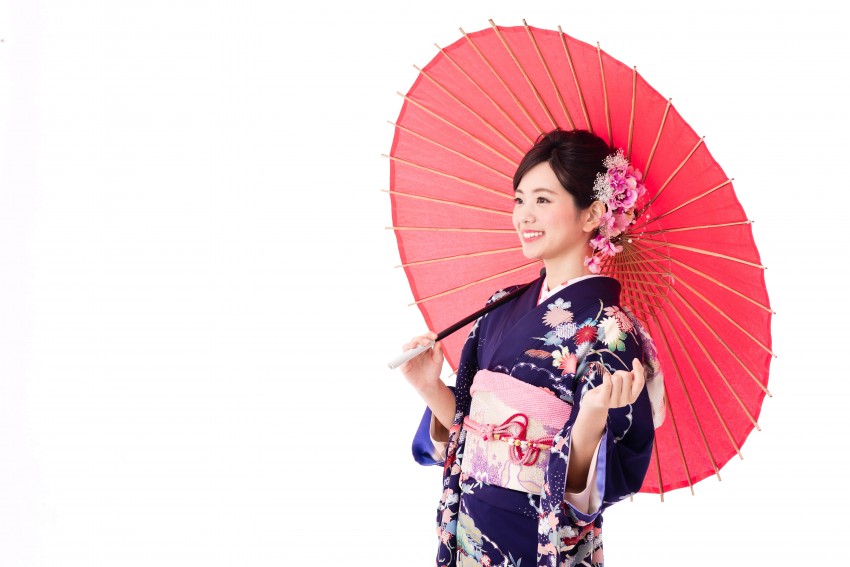
Ancient Origins and Social Status
Kimono color symbolism dates back over 1,000 years to Japan's Heian period (794-1185), when the imperial court established strict guidelines governing who could wear specific colors. These regulations, known as "sumptuary laws," weren't merely fashion rules—they were fundamental aspects of social order that communicated rank, wealth, and position within society.
The most prestigious colors were reserved for the emperor and highest nobility. Purple, particularly deep murasaki (royal purple), could only be worn by those of imperial blood or the highest court ranks. This exclusivity made purple the ultimate symbol of power and refinement in Japanese culture.
The Role of Natural Dyes
Traditional kimono colors were achieved through natural dyes extracted from plants, minerals, and insects. The complexity and cost of obtaining certain colors directly influenced their social significance:
- Safflower red (beni): Extracted from carthamus flowers, this vibrant red required extensive processing and was extremely expensive
- Indigo blue (ai): Made from fermented indigo plants, creating various shades from light blue to deep navy
- Purple (murasaki): Derived from gromwell roots, the most costly and labor-intensive dye to produce
Evolution Through Time Periods
Different historical periods brought changes to kimono color meanings:
- Heian Period (794-1185): Colors indicated court rank and season
- Kamakura Period (1185-1333): Military influences introduced more subdued, practical colors
- Edo Period (1603-1868): Merchant class prosperity led to new color combinations and patterns
- Meiji Period (1868-1912): Western influences began affecting traditional color choices
- Modern Era: Traditional meanings blend with contemporary fashion sensibilities
Complete Guide to Individual Kimono Colors
Red Kimono Meaning: Passion, Joy, and Celebration
Red kimono holds profound significance in Japanese culture, representing life force, vitality, and celebration. The color red (aka in Japanese) is deeply connected to Shinto beliefs about spiritual energy and protection.
Traditional Occasions for Red Kimono:
- Wedding ceremonies (especially for brides)
- New Year celebrations (Oshogatsu)
- Coming-of-age ceremonies (Seijin-no-Hi)
- Festival celebrations (matsuri)
- Children's ceremonies like Shichi-Go-San
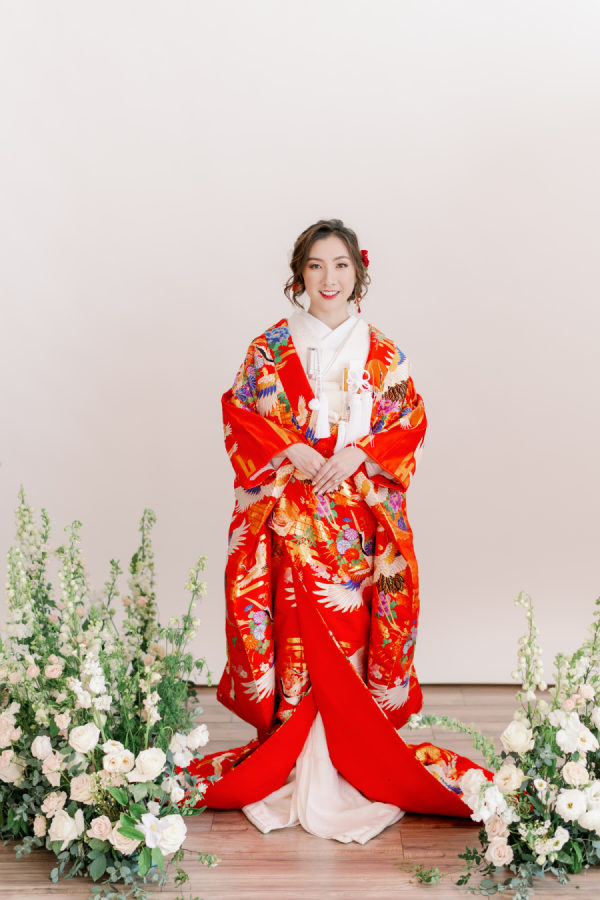
Symbolic Meanings:
- Passion and Love: Red represents romantic love and deep emotional connections
- Protection: Believed to ward off evil spirits and negative energy
- Good Fortune: Associated with prosperity and success in endeavors
- Life Energy: Represents the vital force that drives existence
Photography Impact: Red kimonos create stunning visual drama in photographs. The vibrant color commands attention and creates beautiful contrast against traditional Japanese backgrounds like bamboo groves, temple gardens, or historic architecture. For optimal photographic results, red kimonos work exceptionally well during golden hour lighting or against neutral backgrounds.
Blue Kimono Meaning: Serenity, Wisdom, and Loyalty
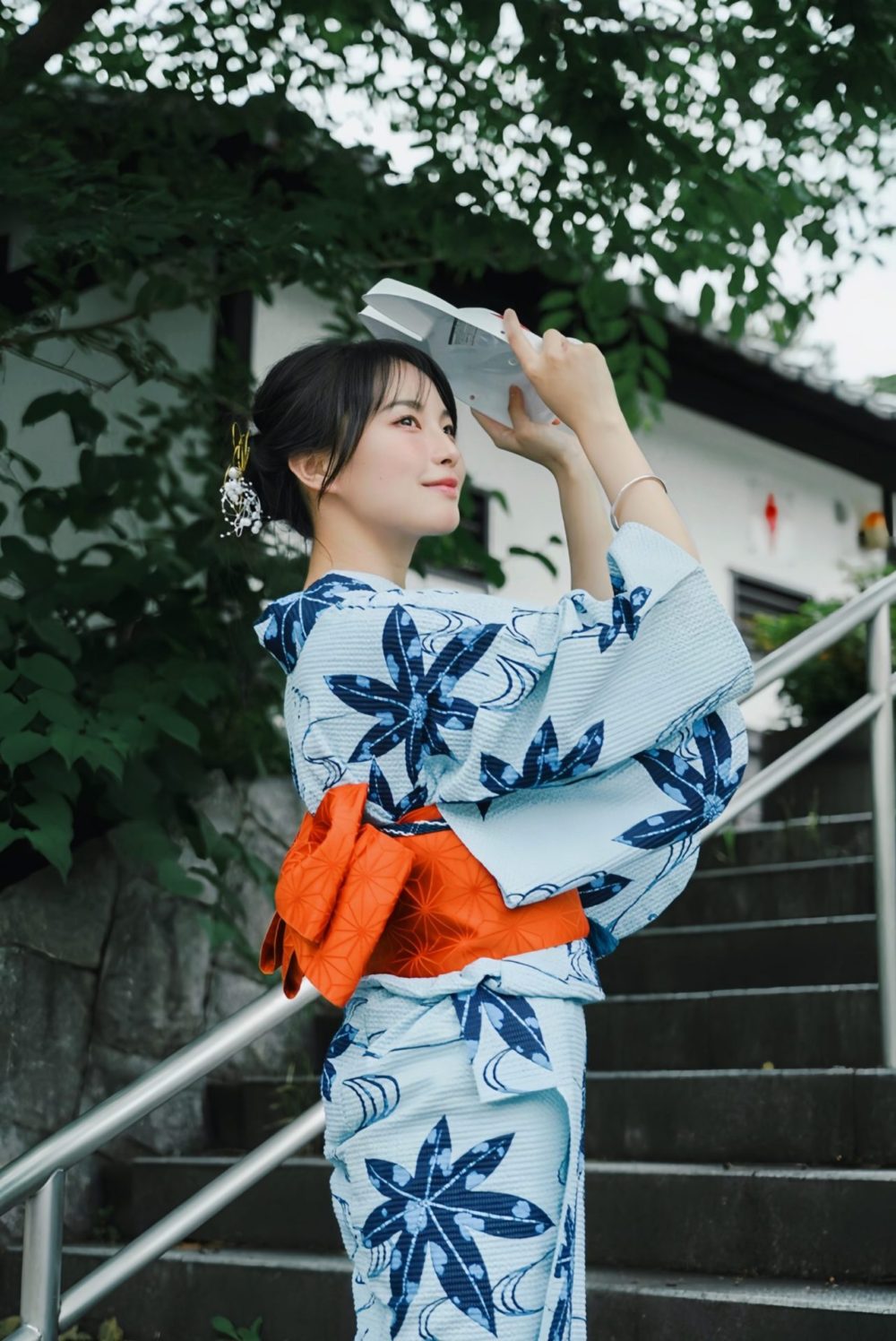
Blue kimono colors range from pale sky blue (mizuiro) to deep navy (kon), each carrying distinct meanings within Japanese tradition. Blue represents stability, trustworthiness, and connection to nature.
Traditional Contexts:
- Summer festivals and casual gatherings
- Tea ceremony participants (lighter blues)
- Business or professional occasions (darker blues)
- Academic ceremonies and scholarly events
Symbolic Interpretations:
- Tranquility: Light blues evoke peace and calm contemplation
- Wisdom: Deeper blues represent knowledge and intellectual depth
- Loyalty: Navy blue symbolizes faithfulness and reliability
- Connection to Nature: Reflects sky and water elements
Seasonal Associations: Blue kimonos are particularly popular during summer months, as the color psychologically creates a cooling effect. Light blue kimonos (asagi) are traditional for summer festivals, while deeper blues work well year-round.
Photographic Considerations: Blue kimonos photograph beautifully in natural settings, particularly near water features, gardens, or traditional architecture. The color complements both warm and cool lighting conditions, making it versatile for various photography styles.
Purple Kimono Meaning: Nobility, Mystery, and Spiritual Depth
Purple kimono represents the pinnacle of elegance and sophistication in Japanese tradition. Historically the most exclusive color, purple continues to convey luxury, wisdom, and spiritual authority.
Historical Significance:
- Reserved for imperial family and highest court officials
- Associated with Buddhist and Shinto religious ceremonies
- Symbol of artistic and intellectual achievement
- Representation of transformation and spiritual growth
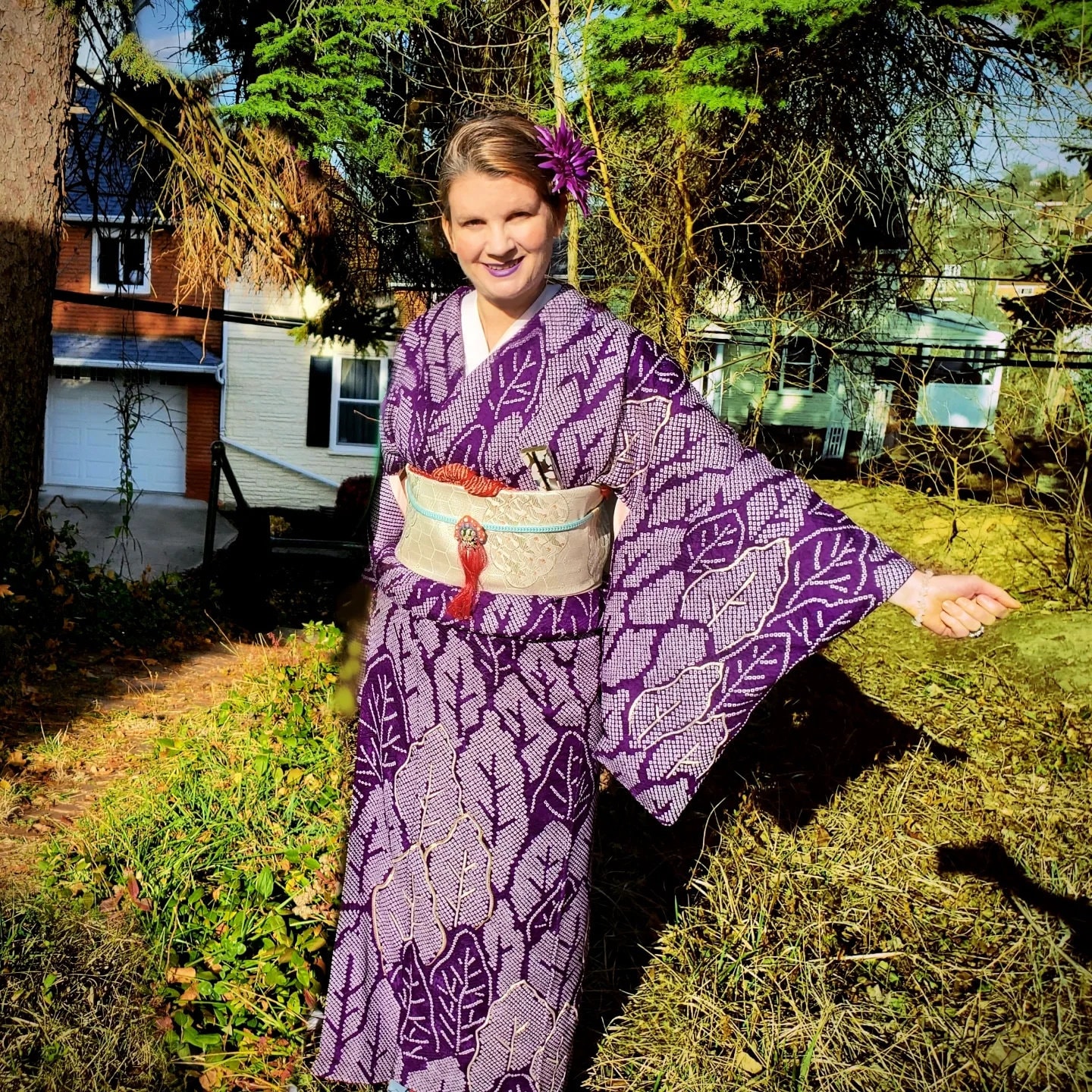
Modern Applications:
- Formal evening events and galas
- Cultural ceremonies and traditional performances
- High-end tea ceremonies
- Artistic and creative celebrations
Symbolic Meanings:
- Royal Authority: Connection to imperial power and governance
- Spiritual Wisdom: Deep understanding and enlightenment
- Mystery and Magic: Association with the unknown and mystical
- Artistic Creativity: Inspiration and innovative thinking
Photography Appeal: Purple kimonos create striking, memorable images with an air of sophistication. The color photographs exceptionally well in golden hour light and creates beautiful contrast with both natural and architectural backgrounds.
Pink Kimono Meaning: Femininity, Youth, and Cherry Blossoms
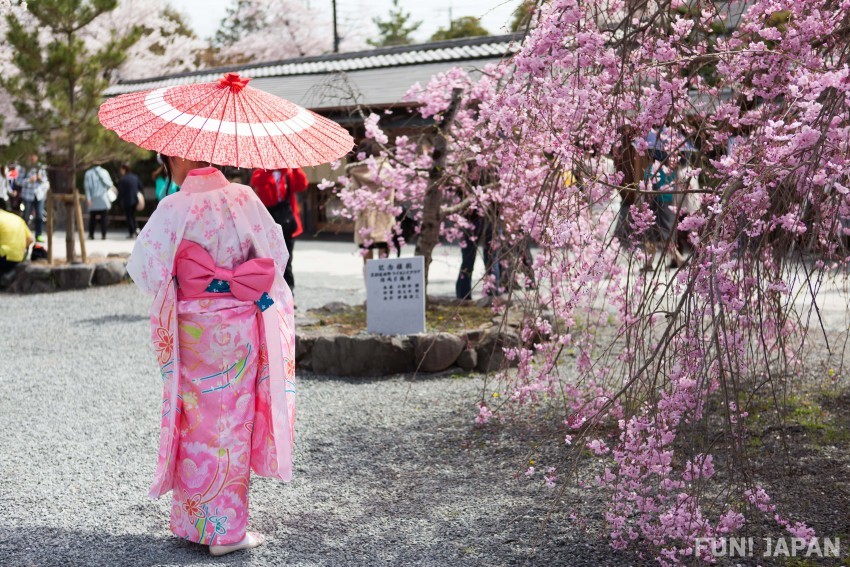
Pink kimono embodies the essence of Japanese femininity and is deeply connected to the beloved cherry blossom (sakura) season. Pink represents gentleness, youth, and the ephemeral beauty of life.
Traditional Occasions:
- Cherry blossom viewing parties (hanami)
- Young women's coming-of-age ceremonies
- Spring festivals and celebrations
- Romantic occasions and courtship events
Cultural Associations:
- Sakura Connection: Direct link to Japan's most beloved flower
- Youthful Beauty: Represents the bloom of young womanhood
- Gentle Strength: Soft power and quiet determination
- Renewal: Spring rebirth and new beginnings
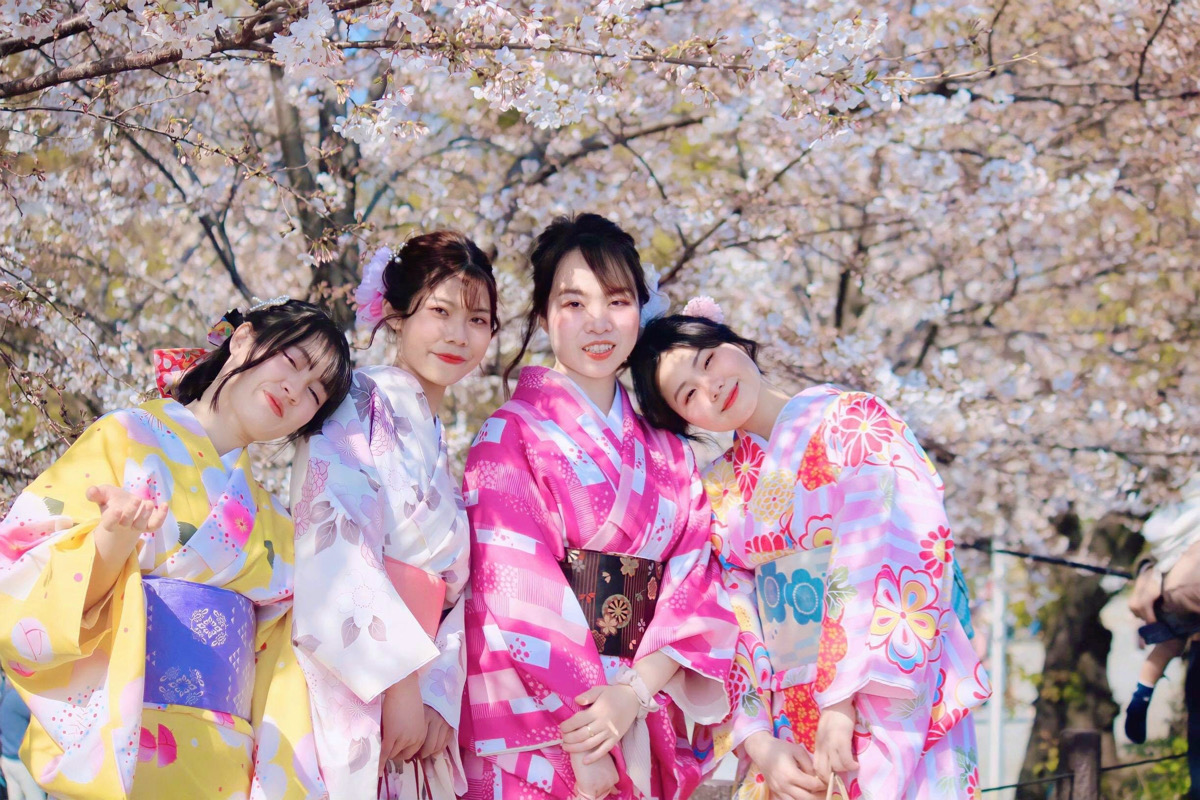
Shade Variations:
- Pale Pink (usu-momo): Subtle elegance and refined taste
- Cherry Blossom Pink (sakura-iro): Traditional spring celebration color
- Deep Pink (koiiro): More dramatic expression of femininity
Orange Kimono Meaning: Energy, Creativity, and Autumn Harvest
Orange kimono colors capture the vibrant energy of autumn and represent creativity, enthusiasm, and abundance. Orange is less common than other kimono colors, making it particularly striking and memorable.
Seasonal Significance: Orange kimonos are traditionally worn during autumn months, reflecting the changing leaves and harvest season. The color connects wearers to nature's cycles and the gratitude associated with harvest time.
Symbolic Meanings:
- Creative Energy: Artistic inspiration and innovative thinking
- Warmth and Friendship: Social connection and hospitality
- Abundance: Material and spiritual prosperity
- Transformation: Change and personal growth
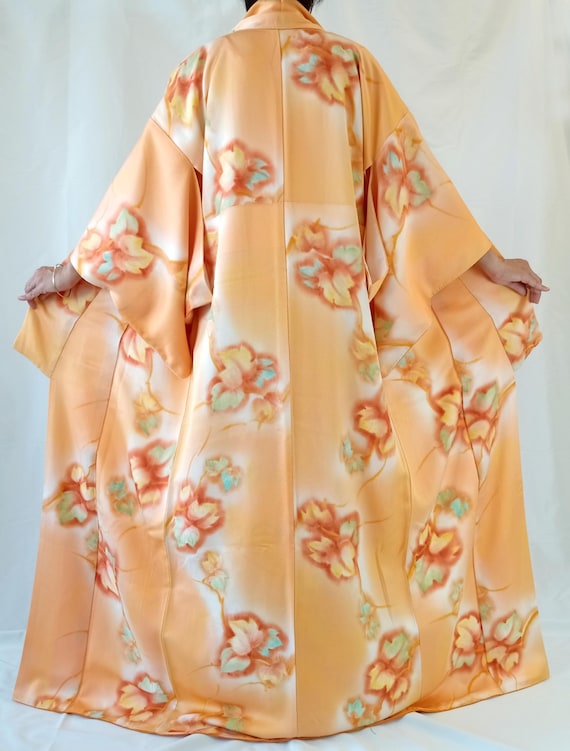
Modern Interpretations: Contemporary kimono wearers choose orange for artistic events, creative gatherings, and occasions where they want to make a bold, positive statement.
Black Kimono Meaning: Formality, Elegance, and Sophisticated Power
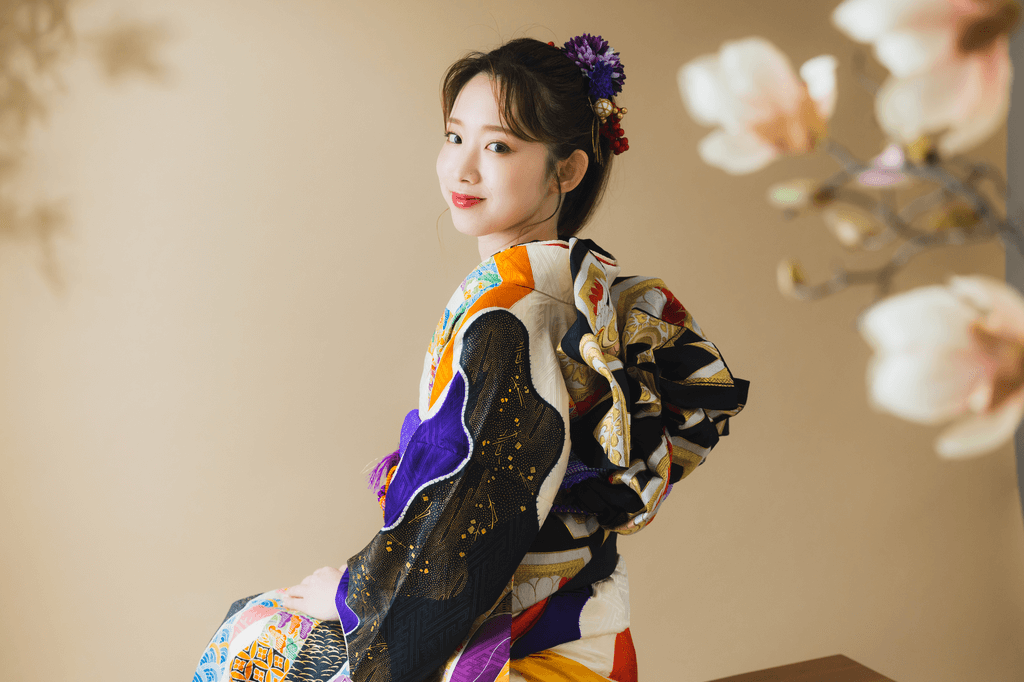
Black kimono (kuro) represents the ultimate in formal elegance and sophisticated restraint. Far from being somber, black kimono conveys authority, timeless style, and understated luxury.
Formal Applications:
- Kurotomesode: The most formal kimono for married women, worn at weddings and important ceremonies
- Kuro-montsuki: Formal black kimono with family crests for ceremonial occasions
- Evening events: Sophisticated gatherings requiring elegant attire
Symbolic Significance:
- Authority and Power: Command respect and attention
- Timeless Elegance: Classic beauty that transcends trends
- Sophisticated Restraint: Refined taste and cultural knowledge
- Protection: Traditional belief in black's protective qualities

Photography Excellence: Black kimonos create dramatic, striking photographs with incredible versatility. They work beautifully as statement pieces against colorful backgrounds or create elegant silhouettes in artistic compositions.
Traditional Kimono Color Combinations
Classical Pairing Principles
Traditional kimono color combinations follow specific aesthetic principles developed over centuries. These combinations aren't random—they reflect deep understanding of color harmony, seasonal appropriateness, and cultural symbolism.
Complementary Combinations:
- Red and White: Celebration and purity (weddings, New Year)
- Blue and White: Tranquility and clarity (summer festivals)
- Purple and Gold: Nobility and prosperity (formal ceremonies)
- Pink and Green: Spring harmony (cherry blossom season)

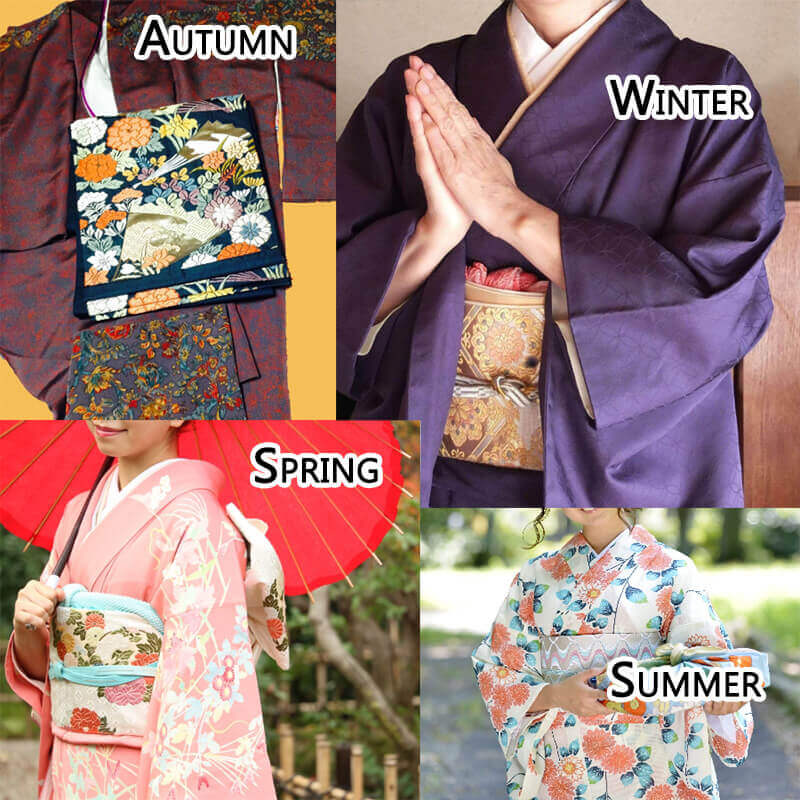
Seasonal Color Schemes
- Spring: Soft pinks, light greens, pale yellows
- Summer: Cool blues, whites, light purples
- Autumn: Rich oranges, deep reds, golden yellows
- Winter: Deep purples, elegant blacks, silver accents
Modern Color Innovation
Contemporary kimono designers blend traditional principles with modern aesthetic sensibilities, creating new combinations that honor heritage while embracing innovation.
Seasonal Considerations in Kimono Color Selection
Spring (Haru) Colors
Spring kimono colors celebrate renewal, growth, and the famous cherry blossom season. Traditional spring palette includes:
- Soft pinks reflecting sakura blossoms
- Fresh greens representing new growth
- Light yellows symbolizing sunshine and optimism
- Pale purples echoing wisteria blooms
Summer (Natsu) Colors
Summer kimono emphasizes cooling colors and breathable fabrics:
- Cool blues creating psychological cooling effect
- Clean whites reflecting heat and maintaining comfort
- Soft grays providing sophisticated neutrality
- Mint greens evoking refreshing natural settings
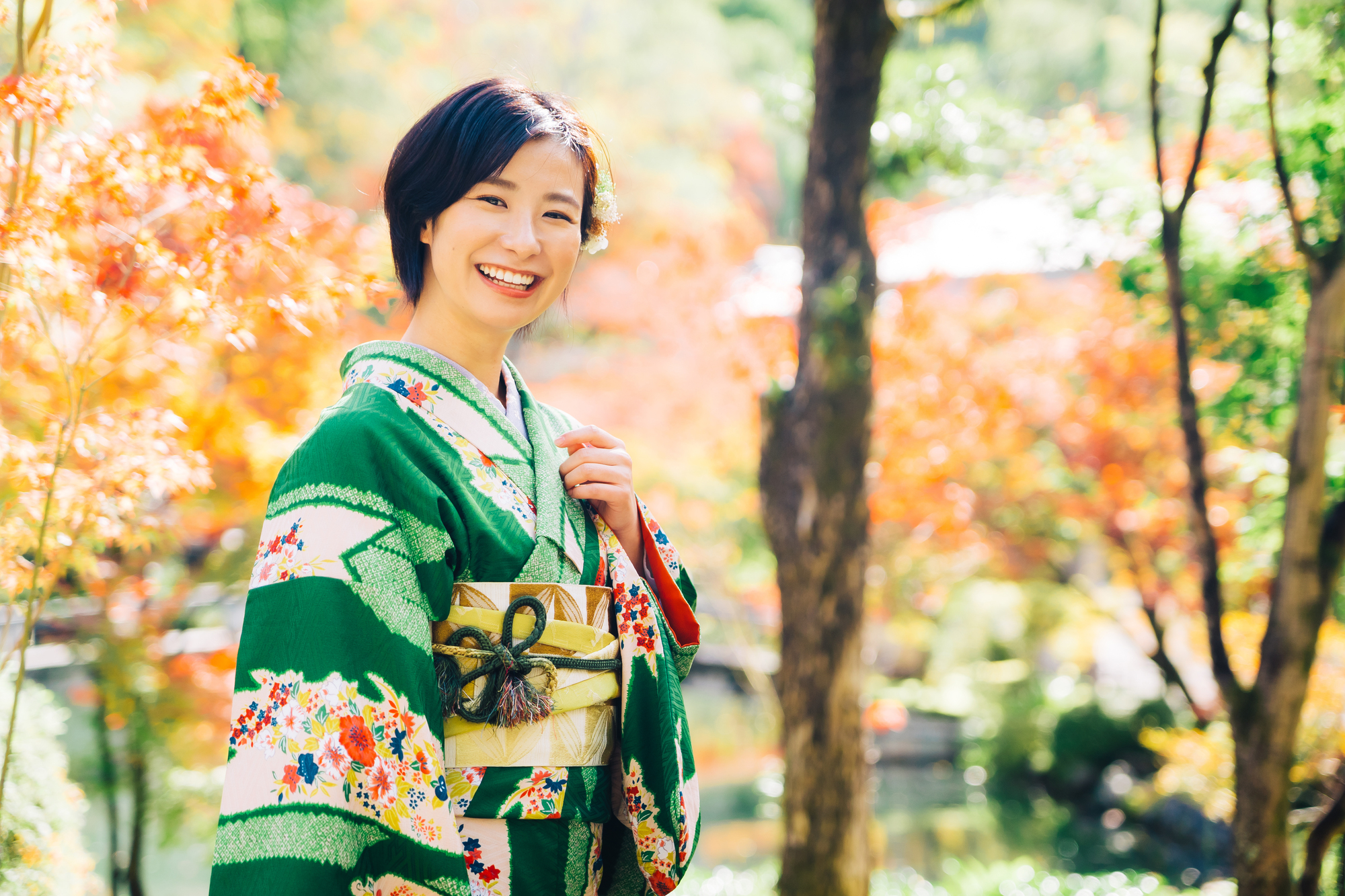
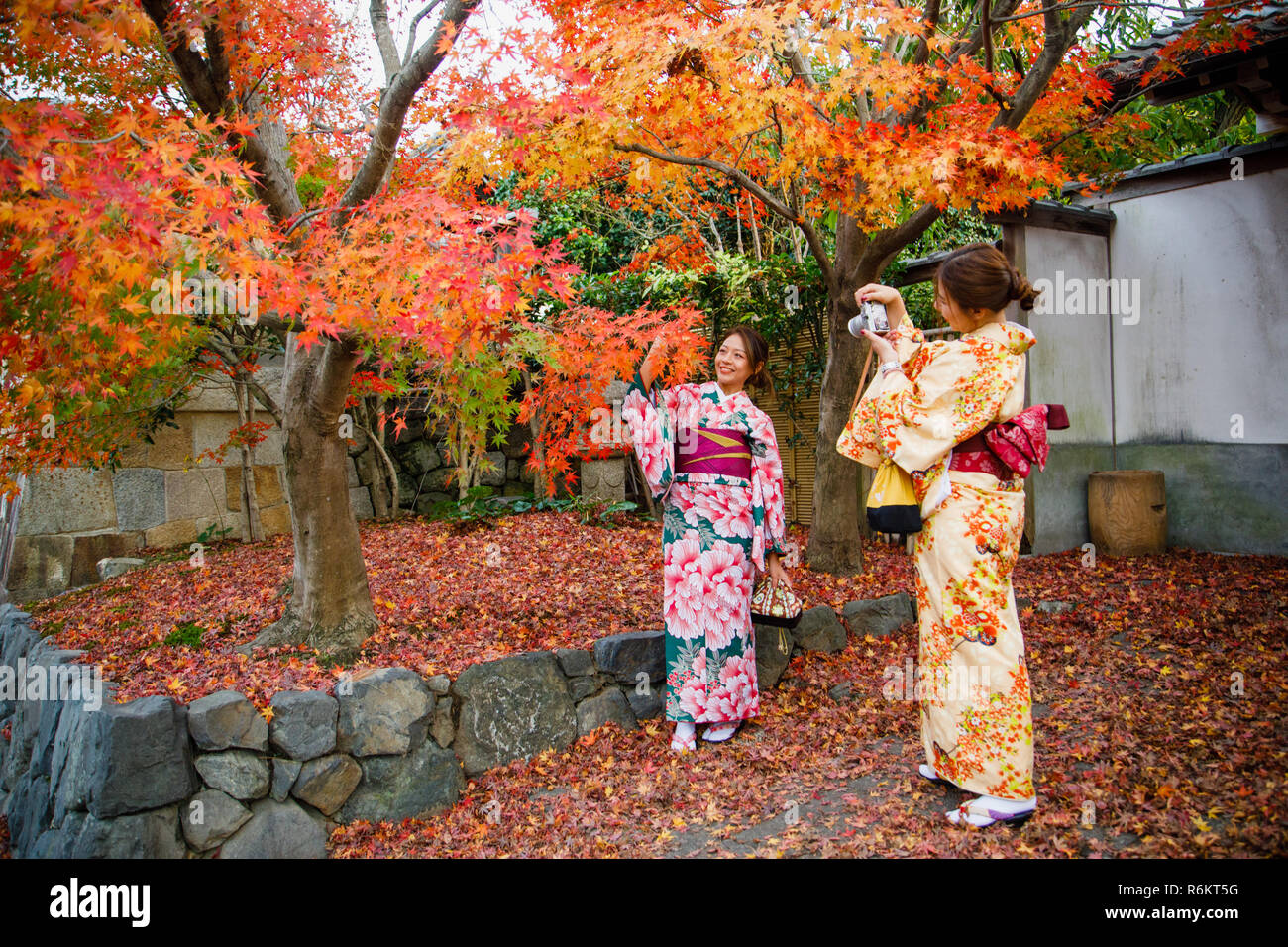
Autumn (Aki) Colors
Autumn kimono captures the season's rich, warm palette:
- Deep oranges reflecting maple leaves
- Rich burgundies symbolizing maturity and harvest
- Golden yellows representing abundance
- Warm browns connecting to earth and stability
Winter (Fuyu) Colors
Winter kimono embraces deeper, more dramatic colors:
- Deep purples conveying sophistication
- Rich blacks creating elegant formality
- Silver accents reflecting winter light
- Dark blues providing depth and mystery
Modern Kimono Photography and Color Impact
Understanding Color Psychology in Photography
Different kimono colors create distinct emotional responses and visual impacts in photography. Understanding these effects helps create more compelling and meaningful images.
Warm Colors (Red, Orange, Pink):
- Create energy and draw immediate attention
- Photograph well in natural lighting
- Perfect for celebratory and joyful occasions
- Work beautifully against cool-toned backgrounds
Cool Colors (Blue, Purple, Green):
- Convey calmness and sophistication
- Excel in both natural and artificial lighting
- Ideal for contemplative and elegant portraits
- Complement warm-toned environmental elements
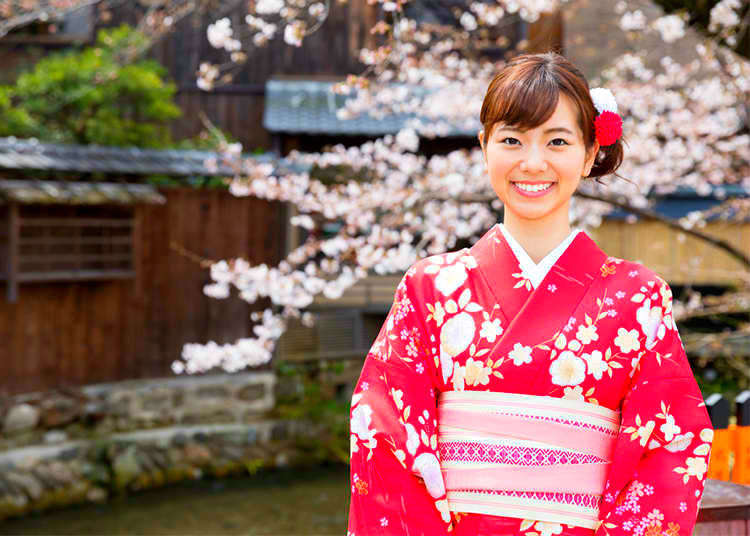
Technical Photography Considerations
Lighting Requirements:
- Red kimonos: Avoid harsh lighting that can create color bleeding
- Dark colors: Require careful lighting to maintain detail
- Light colors: Need protection from overexposure
- Purple: Benefits from soft, diffused lighting
Background Selection:
- Traditional Japanese architecture enhances cultural authenticity
- Natural settings (gardens, bamboo groves) create harmonious compositions
- Neutral backgrounds allow kimono colors to dominate
- Contrasting backgrounds create dramatic artistic effects
Professional Kimono Photography Services
Capturing Kimono Beauty in Kyoto
For those seeking to capture the true essence of kimono colors in their full cultural context, professional photography services can create stunning, memorable images that honor both tradition and personal expression.
AllPhoto Kyoto specializes in authentic kimono photography, offering expert services that understand the cultural significance of kimono colors and how to showcase them beautifully. Their experienced photographers know how to work with different kimono colors to create stunning visual narratives that capture both the garment's beauty and the wearer's personality.
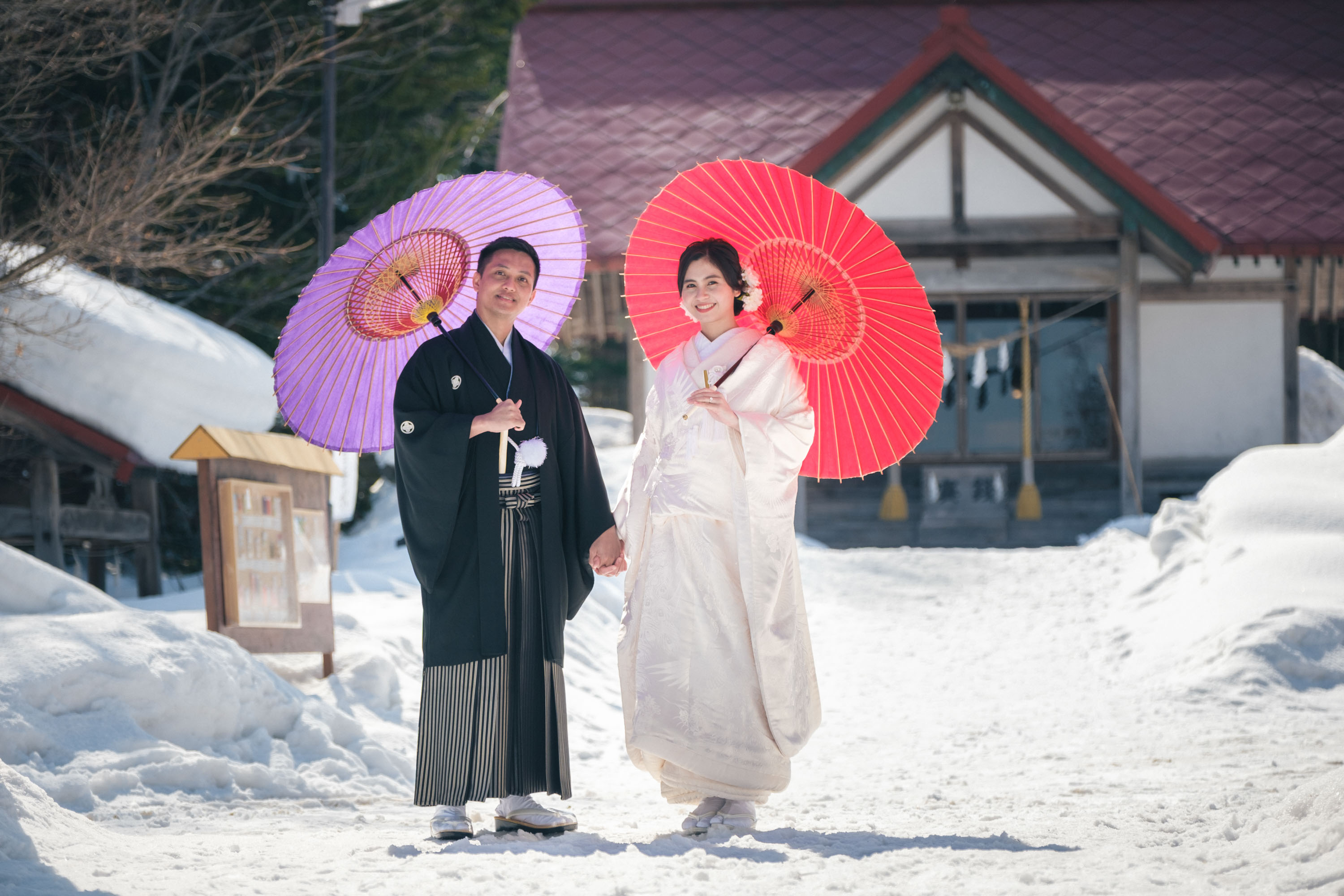
Why Professional Photography Matters
Professional kimono photographers understand:
- Cultural Sensitivity: Proper handling and presentation of traditional garments
- Color Expertise: How different kimono colors photograph under various conditions
- Location Knowledge: Best settings in Kyoto for authentic kimono photography
- Technical Mastery: Proper lighting and composition for textile photography
Frequently Asked Questions About Kimono Colors
What is the most traditional kimono color for weddings?
Traditional Japanese weddings feature different colors depending on the ceremony phase. Red is traditional for the main ceremony (representing joy and good fortune), while white is worn for the sake-sharing ritual (symbolizing purity and the bride's willingness to be "dyed" with her new family's colors).
Can I wear any kimono color as a foreigner?
Yes, visitors to Japan are welcome to wear kimono in any color. While understanding traditional meanings enhances the experience, there are no restrictions on color choices for cultural appreciation and photography.
How do seasonal colors affect kimono selection?
Seasonal appropriateness is highly valued in Japanese culture. Wearing spring colors like pink during cherry blossom season or autumn colors during fall demonstrates cultural sensitivity and aesthetic understanding.
What kimono colors photograph best?
All kimono colors can photograph beautifully with proper technique. Red and orange create vibrant, attention-grabbing images, while blue and purple offer elegant sophistication. Black provides dramatic contrast, and pink creates romantic, gentle portraits.
Are there colors to avoid in kimono?
Traditional etiquette suggests avoiding seasonally inappropriate colors (like bright spring colors in winter) and ensuring color choices match the occasion's formality level. However, these are guidelines rather than strict rules.
How do kimono colors compare to Western color symbolism?
While some meanings overlap (red for passion, blue for tranquility), Japanese color symbolism has unique cultural aspects. Purple's connection to nobility, pink's association with cherry blossoms, and black's formal elegance carry specifically Japanese cultural meanings.
Conclusion: The Timeless Beauty of Kimono Color Symbolism
Kimono colors represent one of the world's most sophisticated systems of symbolic dress, where every hue carries centuries of cultural meaning and artistic tradition. From the passionate red of celebration to the noble purple of imperial heritage, each color tells a story that connects past and present.
Understanding kimono color symbolism enhances appreciation for Japanese culture and creates more meaningful experiences whether wearing kimono, photographing them, or simply admiring their beauty. These colors continue to inspire designers, artists, and cultural enthusiasts worldwide, proving that true beauty transcends time and cultural boundaries.

Whether you're planning a kimono experience in Kyoto, studying Japanese culture, or simply fascinated by the intersection of color and meaning, the world of kimono colors offers endless opportunities for discovery and appreciation. Each shade and combination opens a window into the sophisticated aesthetic sensibilities that have defined Japanese culture for over a millennium.
The next time you see a kimono, remember that you're witnessing not just beautiful clothing, but a complex system of communication where colors speak volumes about tradition, occasion, season, and personal expression. In this way, kimono colors continue to bridge past and present, East and West, tradition and innovation in the most beautiful possible way.